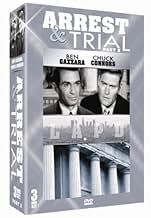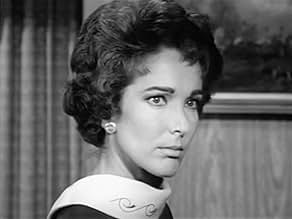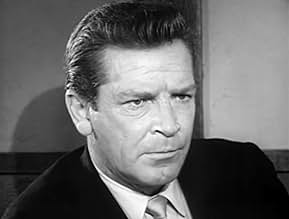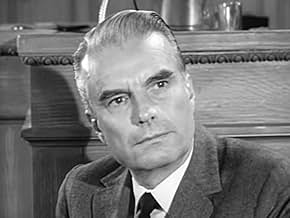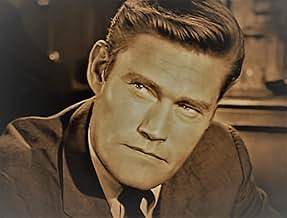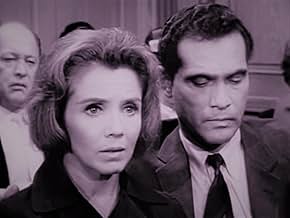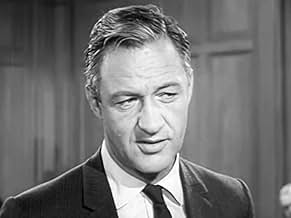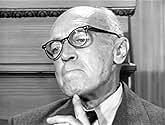AVALIAÇÃO DA IMDb
7,6/10
166
SUA AVALIAÇÃO
Adicionar um enredo no seu idiomaLos Angeles is where Sergeant Nick Anderson and his fellow officers work to keep the streets safe. After the arrest of the accused, attorney John Egan plans their defense, while the prosecut... Ler tudoLos Angeles is where Sergeant Nick Anderson and his fellow officers work to keep the streets safe. After the arrest of the accused, attorney John Egan plans their defense, while the prosecution is led by Jerry Miller.Los Angeles is where Sergeant Nick Anderson and his fellow officers work to keep the streets safe. After the arrest of the accused, attorney John Egan plans their defense, while the prosecution is led by Jerry Miller.
- Indicado para 4 Primetime Emmys
- 4 indicações no total
Explorar episódios
Avaliações em destaque
My title, "Tortured Criminals," refers not to the torturing of criminals but to the fact that on "Arrest and Trial," many or most of the criminals were tortured souls, people out of step with society. Basically good people whose problems, upbringing or outlook on life led them to a criminal act--maybe just one--or to an acting-out crime spree. These lost souls might be addicts, alcoholics, thrill-seekers, seniors experiencing dementia, misguided youth, all of whom seemed okay when not drunk, on drugs, or otherwise affected at the moment by the idiosyncrasies that set them aside from "normal" people. The in-depth look into the character of these lost souls was the heart of the show. Sometimes it just became too much (for the viewer), too maudlin, too many excuses for the improper behavior, too much theorizing about socialization, rehabilitation, upbringing and family life.
The lead casting was a surprise: Ben Gazzara, who went on to star in "Run for Your Life" immediately after the one-year run of "Arrest and Trial," and Chuck Conners, a former baseball player for the Brooklyn Dodgers (among others) who had just finished a 1958-63 stint as the star of "The Rifleman." They didn't quite fit together, although they didn't actually work together since Gazarra was a cop and Conners a prosecuting or defense attorney. Conners, at 6 ft. 6 in. Towered over everybody and didn't seem to fit in the frame. And after a very iconic role as Lucas McCain, the Rifleman, it is hard for viewers to see him as a lawyer, though his penchant for justice and human kindness remained the same.
The supporting cast reads like a list of up-and-coming Who's Who performers, but an outstanding tour de force was accomplished by Jack Weston in the episode, "Birds of a Feather," in which he donned numerous disguises and played completely different characters; sometimes it took a moment to realize it was the same actor.
The music for "Arrest and Trial" leaned toward piano with orchestral background, and sometimes became a bit much; you either like it our you don't. Many of the episodes were shot in interesting locations, a big plus for the one-season series.
All in all, enjoyable, if you can overlook the over-sentimentalization, ongoing behavioral-theory conversations, and an actor who was constantly hitting his head on the underside of the top of your TV set.
The lead casting was a surprise: Ben Gazzara, who went on to star in "Run for Your Life" immediately after the one-year run of "Arrest and Trial," and Chuck Conners, a former baseball player for the Brooklyn Dodgers (among others) who had just finished a 1958-63 stint as the star of "The Rifleman." They didn't quite fit together, although they didn't actually work together since Gazarra was a cop and Conners a prosecuting or defense attorney. Conners, at 6 ft. 6 in. Towered over everybody and didn't seem to fit in the frame. And after a very iconic role as Lucas McCain, the Rifleman, it is hard for viewers to see him as a lawyer, though his penchant for justice and human kindness remained the same.
The supporting cast reads like a list of up-and-coming Who's Who performers, but an outstanding tour de force was accomplished by Jack Weston in the episode, "Birds of a Feather," in which he donned numerous disguises and played completely different characters; sometimes it took a moment to realize it was the same actor.
The music for "Arrest and Trial" leaned toward piano with orchestral background, and sometimes became a bit much; you either like it our you don't. Many of the episodes were shot in interesting locations, a big plus for the one-season series.
All in all, enjoyable, if you can overlook the over-sentimentalization, ongoing behavioral-theory conversations, and an actor who was constantly hitting his head on the underside of the top of your TV set.
Sometimes melodramatic, but intelligent and very well acted early 1960s U.S. TV series, that obviously served as the inspiration for "Law & Order".
Like "L & O" this is divided into 2 parts; "Arrest" where cop Ben Gazzara tracks down the person seemingly guilty of that week's crime and "Trial" where Chuck Connors defends them.
Having the 2nd half be from the defense point-of-view, not the prosecutor's makes the show different than "Law and Order", and arguably more interesting. It makes blatant how much of the legal system exists in shades of gray.
It's not surprising that Ben Gazzara is very, very good as cop Nick Anderson, making him more complex and interesting than your basic TV detective of the era. What caught me off- guard was that Connors as successful attorney John Egan, just about matches him. Unlike Gazzara, Connors was never taken that seriously as an actor,. But he shows a lot here as a top notch, somewhat cynical lawyer. Beyond the two leads, the guest casts were often very strong as well.
It's partly because these were 90 minutes episodes on TV, so each show runs about 75 minutes of screen time, as opposed to the standard TV drama that runs an hour, which means about 45-60 minutes of actual story. With the extra time, the writers fleshed out the characters, both regulars and guests, much more fully than on most non-serialized dramas.
So even if there are plot or logic holes (like charging a man with 1st degree murder, instead of a much more logical 2nd degree or manslaughter, so the trial can be about the issue of "intent" ) it feels more like you're watching a solid, well acted B-film each episode, instead of an early TV series. And the series has a nice mix of dark edginess and humanism.
Yes, the score can be painfully over-the-top, and some of the resolutions are too neat, but I'd still say this holds up favorably to a lot of the modern U.S. character cop and/or lawyer shows of today.
Like "L & O" this is divided into 2 parts; "Arrest" where cop Ben Gazzara tracks down the person seemingly guilty of that week's crime and "Trial" where Chuck Connors defends them.
Having the 2nd half be from the defense point-of-view, not the prosecutor's makes the show different than "Law and Order", and arguably more interesting. It makes blatant how much of the legal system exists in shades of gray.
It's not surprising that Ben Gazzara is very, very good as cop Nick Anderson, making him more complex and interesting than your basic TV detective of the era. What caught me off- guard was that Connors as successful attorney John Egan, just about matches him. Unlike Gazzara, Connors was never taken that seriously as an actor,. But he shows a lot here as a top notch, somewhat cynical lawyer. Beyond the two leads, the guest casts were often very strong as well.
It's partly because these were 90 minutes episodes on TV, so each show runs about 75 minutes of screen time, as opposed to the standard TV drama that runs an hour, which means about 45-60 minutes of actual story. With the extra time, the writers fleshed out the characters, both regulars and guests, much more fully than on most non-serialized dramas.
So even if there are plot or logic holes (like charging a man with 1st degree murder, instead of a much more logical 2nd degree or manslaughter, so the trial can be about the issue of "intent" ) it feels more like you're watching a solid, well acted B-film each episode, instead of an early TV series. And the series has a nice mix of dark edginess and humanism.
Yes, the score can be painfully over-the-top, and some of the resolutions are too neat, but I'd still say this holds up favorably to a lot of the modern U.S. character cop and/or lawyer shows of today.
The short lived television series "Arrest And Trial" was the forefront of the critically acclaimed dramas of the 1960's. This part police procedure, part detective drama, and part courtroom drama was on the same level as "Perry Mason", "The Defenders", and "Dragnet" that lasted one season on ABC's prime time schedule airing on Sunday nights from 8:30-10:00pm (Eastern) that ran 90 minutes with commercials and station identification airing from September 15, 1963 until April 19, 1964. A total of 30 episodes were produced in black and white with the series being produced by Revue Studios/Universal Television and was filmed at the studios of Universal City in association with the ABC Television Network.
The series faced stiff competition on it's Sunday night schedule where it went up against NBC's "The Bill Dana Show", and "Bonanza ",and the second half of CBS' "The Ed Sullivan Show",and "The Judy Garland Show". The majority of the episodes consisted of two segments. First was "The Arrest" that follows Detective Sergeant Nick Anderson (Ben Gazzara) and his partner Detective Dan Kirby(Roger Perry) of the Los Angeles Police Department along with Lieutenant Detective Carl Bowie (Noah Keen) along with Detective Mitchell Harris (Don Galloway) and Joesph Higgins as they solve crimes and vicious murders as they hunt down and captured vicious criminals who may have been connected to other acts as well as other crimes in which they bring them to justice. The apprehended suspect is read his constitutional rights and is brought to trial in a court of law.
The second half of the program "The Trial" begins with the defended being assigned to the criminal attorney John Egan (Chuck Conners) who was often against the Deputy District Attorney Jerry Miller (John Larch) and the Assistant District Attorney(Barry Pine) where the defended is tried and convicted before a judge and a jury whether if they are found guilty or not guilty depending on the outcome of the case. The series was nominated for Four Prime Time Emmys for Outstanding Dramatic Series during it short lived run. With executive producer Frank P. Rosenburg along with producers Earl Bellamy, Arthur H. Nadel and Charles Russell this series was absolutely brilliant that had a plethora of guest stars each week with top notch direction and fantastic writing that set the tone in modern day 1960's Los Angeles. The best episodes from the series were "Onward and Upward", "Roll Of The Dice", "The Witnesses", "A Shield Is For Hiding Behind", "Inquest For A Bleeding Heart", "Tears From A Silver Dipper", and "Call It A Lifetime".
Creator and producer Dick Wolf Of "Law and Order" took a cue from this 1960's television series and adapted it in the 1990's that had the same format but it was more successful. But still "Arrest And Trial" remains a bonafide classic of brilliant television from the 1960's that was critically acclaimed but was suddenly canceled that still requires a good look.
The series faced stiff competition on it's Sunday night schedule where it went up against NBC's "The Bill Dana Show", and "Bonanza ",and the second half of CBS' "The Ed Sullivan Show",and "The Judy Garland Show". The majority of the episodes consisted of two segments. First was "The Arrest" that follows Detective Sergeant Nick Anderson (Ben Gazzara) and his partner Detective Dan Kirby(Roger Perry) of the Los Angeles Police Department along with Lieutenant Detective Carl Bowie (Noah Keen) along with Detective Mitchell Harris (Don Galloway) and Joesph Higgins as they solve crimes and vicious murders as they hunt down and captured vicious criminals who may have been connected to other acts as well as other crimes in which they bring them to justice. The apprehended suspect is read his constitutional rights and is brought to trial in a court of law.
The second half of the program "The Trial" begins with the defended being assigned to the criminal attorney John Egan (Chuck Conners) who was often against the Deputy District Attorney Jerry Miller (John Larch) and the Assistant District Attorney(Barry Pine) where the defended is tried and convicted before a judge and a jury whether if they are found guilty or not guilty depending on the outcome of the case. The series was nominated for Four Prime Time Emmys for Outstanding Dramatic Series during it short lived run. With executive producer Frank P. Rosenburg along with producers Earl Bellamy, Arthur H. Nadel and Charles Russell this series was absolutely brilliant that had a plethora of guest stars each week with top notch direction and fantastic writing that set the tone in modern day 1960's Los Angeles. The best episodes from the series were "Onward and Upward", "Roll Of The Dice", "The Witnesses", "A Shield Is For Hiding Behind", "Inquest For A Bleeding Heart", "Tears From A Silver Dipper", and "Call It A Lifetime".
Creator and producer Dick Wolf Of "Law and Order" took a cue from this 1960's television series and adapted it in the 1990's that had the same format but it was more successful. But still "Arrest And Trial" remains a bonafide classic of brilliant television from the 1960's that was critically acclaimed but was suddenly canceled that still requires a good look.
Created by Earl Bellamy, "Arrest and Trial" was an early attempt to meld, a la "Law and Order", the processes of apprehending criminals, then following the legal system as the cases would be resolved. As 'cop' shows and 'lawyer' shows were among television's most popular genres at the time, ABC and Universal thought the program would be a major hit, and provided first-class talent both in front of, and behind the camera.
The 'Arrest' phase starred 33-year old Ben Gazzara, a highly respected actor who had made his mark on Broadway in "Cat On a Hot Tin Roof", and in film, in ANATOMY OF A MURDER. Possessing a quick, analytical mind, and a wry sense of humor, Gazzara's 'Nick Anderson' would quickly cut through alibis, and make arrests, aided by fellow detectives Roger Perry ("Harrigan and Son") and Noah Keen ("The Crimebusters").
The 'Trial' phase returned TV's "Rifleman", Chuck Connors, to the small screen, as John Egan, an intimidating yet sensitive attorney, and featured veteran actors John Larch (WRITTEN ON THE WIND) and John Kerr (SOUTH PACIFIC) as D.A.s representing the State.
While not as intellectual as "The Defenders", "Arrest and Trial" was unique as either side could win or lose a case, as opposed to Perry Mason's nearly flawless record. This was heady stuff for the early sixties!
Unfortunately, being on television's 'Number 3' network did the series in, as ABC had a much harder time attracting viewers than CBS and NBC, particularly when the program was promoted as 'quality'.
It would take 30 years before "Law and Order" could make the formula work!
The 'Arrest' phase starred 33-year old Ben Gazzara, a highly respected actor who had made his mark on Broadway in "Cat On a Hot Tin Roof", and in film, in ANATOMY OF A MURDER. Possessing a quick, analytical mind, and a wry sense of humor, Gazzara's 'Nick Anderson' would quickly cut through alibis, and make arrests, aided by fellow detectives Roger Perry ("Harrigan and Son") and Noah Keen ("The Crimebusters").
The 'Trial' phase returned TV's "Rifleman", Chuck Connors, to the small screen, as John Egan, an intimidating yet sensitive attorney, and featured veteran actors John Larch (WRITTEN ON THE WIND) and John Kerr (SOUTH PACIFIC) as D.A.s representing the State.
While not as intellectual as "The Defenders", "Arrest and Trial" was unique as either side could win or lose a case, as opposed to Perry Mason's nearly flawless record. This was heady stuff for the early sixties!
Unfortunately, being on television's 'Number 3' network did the series in, as ABC had a much harder time attracting viewers than CBS and NBC, particularly when the program was promoted as 'quality'.
It would take 30 years before "Law and Order" could make the formula work!
When Dick Wolf was creating "Law and Order", he was told there had already been a show that followed a crime from it's commission through the investigation the arrest and the subsequent trial. It was called "Arrest and Trial" and was on from 1963-64, a quarter century before the pilot for "Law and Order", (I'll call them A&T and L&O). Wolf screened an episode of A&T and concluded that their show was very different from his. He was right. The biggest difference, however, was not in concept but in time.
A&T is a 90 minute show, L&O an hour. L&O is a story-driven show with the nature of it's characters suddenly and starkly revealed. A&T is a character study that shows situations developing over time and their effect on people as they happen. In L&O the cops are cops but the lawyers are prosecutors, attempting to forge justice using the imperfect tool of the law. Their adversaries are usually rather sleazy criminals who cared about no one but themselves and their equally self-interested attorneys, people who care nothing about law or justice but just want to win. In A&T the cops are part psychoanalysts and the criminals victims of tragic circumstances. The lawyers are highly principled defense attorneys. The prosecutor is a very friendly adversary who almost reluctantly does his job, even though he may even be sympathetic toward the accused. L&O is mostly about legal issues as the lawyers dual with each other. Whatever moral issues come up have been violated by the criminals. In A&T, there is always some great moral issue that dominates the question of whether the accused is guilty of the crime. How do we treat the insane? Drug addicts? The emotionally distraught?
When I had a chance to view A&T myself after many years of watching L&O, I found it a pleasant surprise, perhaps the most underrated show of my favorite TV decade, the Sixties. The length and emphasis on crime as human tragedy provided some very fine actors such as James Whitmore, Joseph Schildkraut, Mickey Rooney, Roddy McDowell, (who starred in a version of "Crime and Punishment") and many others with tours de force. The writing and acting was very strong. Ben Gazzara, (who I recently spotted in an L&O episode, with his voice apparently dubbed for some reason- I hope he isn't having health problems), played a very thoughtful and sympathetic policeman and Chuck Conners was fine and forceful as an idealistic attorney. It's a consistently entertaining show, one that covers much of the same ground as the excellent "The Defenders" from the same period.
But it's clearly a product of it's time. There are no bad guys. The victims are often faceless or minor characters. Prosecutors and defense attorneys are brothers in arms, fighting for what's right. There's never talk of a deal. This was from a time when, in the last generation, we'd survived a depression, won a war, were holding back Communism and reaching for the moon. We were going to get rid of poverty and injustice. A great many shows presented the contemporary world, one with problems but problems which seemed soluble with heroic effort. Dr. Kildare, Mr. Novak, The Defenders, East Side West Side, Naked City, even Route 66. A&T was definitely a product of this environment.
L&O is product of a much more cynical age, one where people are grubbing for whatever they can get, protecting their own interests and bending the law anyway they can to get what they want out of it.
A&T is a 90 minute show, L&O an hour. L&O is a story-driven show with the nature of it's characters suddenly and starkly revealed. A&T is a character study that shows situations developing over time and their effect on people as they happen. In L&O the cops are cops but the lawyers are prosecutors, attempting to forge justice using the imperfect tool of the law. Their adversaries are usually rather sleazy criminals who cared about no one but themselves and their equally self-interested attorneys, people who care nothing about law or justice but just want to win. In A&T the cops are part psychoanalysts and the criminals victims of tragic circumstances. The lawyers are highly principled defense attorneys. The prosecutor is a very friendly adversary who almost reluctantly does his job, even though he may even be sympathetic toward the accused. L&O is mostly about legal issues as the lawyers dual with each other. Whatever moral issues come up have been violated by the criminals. In A&T, there is always some great moral issue that dominates the question of whether the accused is guilty of the crime. How do we treat the insane? Drug addicts? The emotionally distraught?
When I had a chance to view A&T myself after many years of watching L&O, I found it a pleasant surprise, perhaps the most underrated show of my favorite TV decade, the Sixties. The length and emphasis on crime as human tragedy provided some very fine actors such as James Whitmore, Joseph Schildkraut, Mickey Rooney, Roddy McDowell, (who starred in a version of "Crime and Punishment") and many others with tours de force. The writing and acting was very strong. Ben Gazzara, (who I recently spotted in an L&O episode, with his voice apparently dubbed for some reason- I hope he isn't having health problems), played a very thoughtful and sympathetic policeman and Chuck Conners was fine and forceful as an idealistic attorney. It's a consistently entertaining show, one that covers much of the same ground as the excellent "The Defenders" from the same period.
But it's clearly a product of it's time. There are no bad guys. The victims are often faceless or minor characters. Prosecutors and defense attorneys are brothers in arms, fighting for what's right. There's never talk of a deal. This was from a time when, in the last generation, we'd survived a depression, won a war, were holding back Communism and reaching for the moon. We were going to get rid of poverty and injustice. A great many shows presented the contemporary world, one with problems but problems which seemed soluble with heroic effort. Dr. Kildare, Mr. Novak, The Defenders, East Side West Side, Naked City, even Route 66. A&T was definitely a product of this environment.
L&O is product of a much more cynical age, one where people are grubbing for whatever they can get, protecting their own interests and bending the law anyway they can to get what they want out of it.
Você sabia?
- CuriosidadesAlthough Chuck Connors was considered to be miscast as an attorney, much of the failure of this show to live up to its potential was allegedly due to interference in the show's writing by producer Frank P. Rosenberg. Connors is said to have butted heads many times with management over this, as well as its treatment of the show's staff (he once walked off the set until the studio resumed providing free coffee and donuts for the crew). Rosenberg was said to have a stack of "Arrest and Trial" scripts written by some of the top writers in Hollywood that were ignored, in favor of scripts that were increasingly mediocre. This show was also in one of the worst possible time slots, competing against Bonanza (1959), Toast of the Town (1948), and The Judy Garland Show (1963). When this show folded after one season, Connors, Universal, and Revue severed their contract by "mutual agreement". A year later, Connors was back on television in another western, Branded (1965) that, oddly enough, ran in the same unenviable time slot as this show, but managed to last two seasons. Ben Gazzara returned to enjoy a three-year run on the television series Run for Your Life (1965), before appearing in three critically acclaimed films directed by his friend, independent film pioneer, John Cassavetes.
- ConexõesRemade as Arrest & Trial (2000)
Principais escolhas
Faça login para avaliar e ver a lista de recomendações personalizadas
- How many seasons does Arrest and Trial have?Fornecido pela Alexa
Detalhes
- Data de lançamento
- País de origem
- Idioma
- Também conhecido como
- Arrest and Trial
- Locações de filme
- Empresas de produção
- Consulte mais créditos da empresa na IMDbPro
- Tempo de duração1 hora 30 minutos
- Cor
- Mixagem de som
- Proporção
- 1.33 : 1
Contribua para esta página
Sugerir uma alteração ou adicionar conteúdo ausente

Principal brecha
By what name was Culpado ou Inocente (1963) officially released in India in English?
Responda
